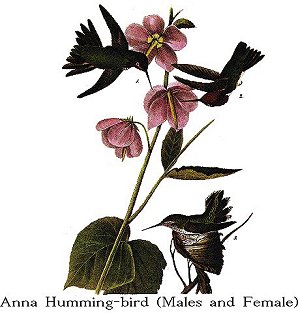
| Family XXIV. TROCHILINAE. HUMMING-BIRDS. GENUS I. Linn. TROCHILUS HUMMING-BIRD. |
Next >> |

Family |
ANNA HUMMING-BIRD. [Anna's Hummingbird.] |
| Genus | TROCHILUS ANNA, Less. [Calypte anna.] |
My good friend THOMAS NUTTALL, while travelling from the Rocky Mountains
toward California, happened to observe on a low oak bush a Humming-bird's nest
on which the female was sitting. Having cautiously approached, he secured the
bird with his hat. The male in the meantime fluttered angrily around, but as my
friend had not a gun, he was unable to procure it.
The nest, which he has presented to me, is attached to a small branch, and
several leaves from a twig issuing from it, which have apparently been bent down
for the purpose. It is very small, even for the size of the bird, being an inch
and a half in depth, and an inch and a quarter in breadth externally at the
mouth, while its internal diameter is ten-twelfths, and its depth eight and a
half twelfths. It is of a conical form, and composed of the cottony down
apparently of some species of willow, intermixed with scales of catkins and a
few feathers, and lined with the same substances. The eggs, two in number, are
pure white, of a nearly elliptical form, five-twelfths of an inch long, and
three and a quarter twelfths in their greatest breadth.
The figures of the nest and female are taken from the specimens presented
to me by Mr. NUTTALL. Those of the male I made from specimens, for the use of
which I am indebted to Mr. LODDIGE, of London, whose collection of Humming-birds
is unrivalled. This species is the fourth now found within the limits of the
United States.
OISEAU-MOUCHE ANNA, Ornismya Anna, Less. Traite d'Ornith., P. 281.
ANNA HUMMING-BIRD, Trochilus Anna, Aud. Orn. Biog., vol. v. p. 238.
Male, 3 10/12, wing, 2 1/12.
Rocky Mountains towards California. Common. Migratory.
Adult Male.
Bill long, very slender, cylindrical, slightly depressed at the base,
acuminate; upper mandible with the dorsal line straight, the ridge narrow at the
base and convex toward the end, the sides convex, the edges overlapping; lower
mandible with the angle very long and extremely narrow, the dorsal line slightly
decurvate, the tip forming a very slender point. Nostrils basal, linear.
Head of ordinary size, oblong; neck short; body slender. Feet very small;
tarsus extremely short, rather stout, feathered more than half-way down; toes
small, the lateral equal, the middle toe not much longer, the hind toe a little
shorter than the lateral; anterior toes united at the base; claws rather long,
stout, arched, compressed, laterally grooved, very acute.
Plumage soft and blended; feathers on the upper part of the head, cheeks,
and throat, oblongo-obovate, with their filaments toward the end thickened and
flattened, with metallic gloss, those on the sides of the neck more elongated.
Wings rather long, extremely narrow, somewhat falcate; the primaries rapidly
graduated, the first being longest; the number of quills sixteen. Tail of
moderate length, emarginate and rounded.
Bill and feet black. The compact feathers of the head, cheeks, and throat
are blood-red, changing to gold, and having a tinge of blue; the upper parts
light gold-green; the quills and tail-feathers dusky brown; the lower parts
brownish-white.
Length to end of tail 3 10/12 inches; bill along the ridge 10/12; wing from
flexure 2 1/12; tail 1 1/4; tarsus 2/12; hind toe (1 1/2)/12, its claw
(1 1/4)/12; middle toe (2 1/2)/12, its claw (1 1/2)/12.
Female.
The female differs from the male in several respects. The tail is rounded,
without emargination; the metallic feathers are reduced to an irregular patch on
the throat; the upper part of the head and the cheeks are greenish-grey, the
upper parts glossy green as in the male, the wings dusky, the middle
tail-feathers green, the rest greenish-grey at the base, black toward the end,
with the tip white; the lower parts dull grey, the sides tinged with green.
Length to end of tail 3 9/12 inches; bill along the ridge (9 1/4)/12; wing
from flexure 2; tail 1 1/4.
| Next >> |